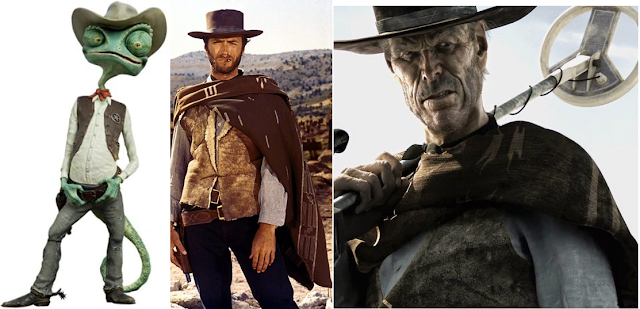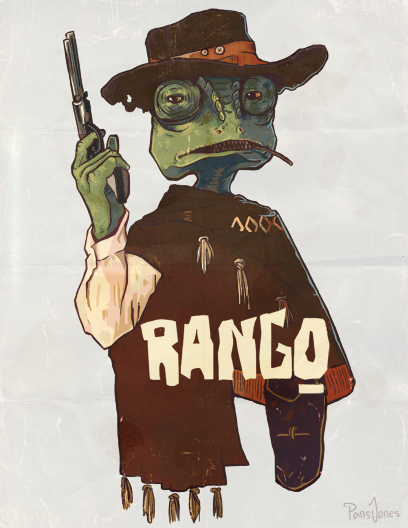Well howdy there! I know many among us enjoy the thrill of the Wild West movies. I mean, what is there not to like? Whenever it comes to a Wild West title, what will you think of first? I bet it is going to be a tons of cowboys, six-shooters, towns, settlements, night camps, deserts, Indians… We can go on and on and the list can never truly end.
While most of the features in a Wild West movie are considered public setting and free to use, there has been one particular feature that should be unique, which is the character of the movie. However, when a fictional character became too successful, many others film makers would like to make an adaptation based on such character. But is it copyright violation? Such instance can be found in the “standoff” between “Rango” and “A Fistful of Dollars”.

A Fistful of Dollars vs. Rango
A Fistful of Dollars
“A Fistful of Dollars” (1964) is the first movie of the Dollars Trilogy, which also featured “For a Few Dollars More” (1965) and “The Good, the Bad and the Ugly” (1966), a Italian directed film series lead by Director Sergio Leone and this series can be considered one of the Western “classics”.
All three film featured Clint Eastwood as the main protagonist, by the alias of “Man with No Name”. Beside the talent of the actor, what made “Man with No Name” stands out also are cigar smoking, the same attire (Poncho, sharp fedora) during the whole trilogy.
The series’ success not only gives it the title of “Western Classics” (or “Spaghetti Western”) to the Dollars series but also makes Clint Eastwood’s character became one of the most inspirational source for many to adapt. Many even claim that “Man with No Name” has defined to “Western style”. Indeed, to this very day, none has made other design that is able to outmatch Clint’s style.
Rango
Directed by Gore Verbinski, Rango is the Western animated comedy film. The story revolving around Rango, a pet chameleon who fancies himself as an actor, who later accidentally ended up in the town of Dirt (Dust in Italian version). The town Dirt is a lawless outpost in the Wild West, inhabited by most wily and whimsical creatures. Rango became the sheriff of that lawless town. Though he was acting up in the first place, many outrageous encounters forced him to become a real hero.
Rango is more like “a film within a film”. Verbinski has flawlessly put in many references to the Western and many other movie. Rango plays out with many familiar scenes while also features its own plot and character is both clever and brilliant.
That “scene”
Everything stays pretty quiet between the two movies, as there is almost no relation between them other than the Wild West setting. However, due to the comedic parody nature of Rango, it featured lots of other Western movies features.
In one pivotal scene, Rango dreamed of “Spirit of the West”, who is a metacinema character that gave direction and encouragement to Rango. What special is that “Spirit of the West” resembles an elderly “Man with No Name”, smoking cigar, wearing the same poncho with a sharp fedora.
Because of this one particular scene, Rango and the A fistful of Dollars became two gunslingers in a duel.
The “Standoff”
Rango was callout in the Court of Rome by the Dollars. However, this was called off by the Court’s brilliant decision. Base on a genuine passion for the Seventh Art, the courts dismissed the claims, following these arguments:
Context
The two films are totally different in regard to their context. While the first one being “dramatic and developed on a growing narrative tension”; the second is just “satirical and semi-serious … seemingly intended mainly for children”.
The reference
“Spirit of the West” clearly was not made to refer to the character Man with No Name, but rather to the actor himself. In Rango, the Spirit of the West represent an elderly gentleman who drives a golf caddy, with a golf bag full of Academy Awards. This clearly sights that the movie Rango trying to represent an elderly Clint Eastwood, not the young gunslinger “Man with No Name” from the Trilogy.
The role and playtime
“Man with No Name” is basically the main protagonist of the “spaghetti Western”; while “Spirit of the West plays a “temporally limited role lasting not even two minutes” and has the clear purpose “of paying a clear tribute to the main actor of the spaghetti western saga and to his director Sergio Leone”. Because of this intention, the decision refers expressly to the I.S fair use doctrine, which consider Rango’s reference is a “commercially harmless” plagiarism. Thus, exclude this scene from the case of copyright infringement.
The semantic gap
According to Italian case law, in order to be protected by copyright as a creative work, a character “must be original and immediately recognizable even if the same character is or is placed in a different context”; therefore, it must show a “semantic gap” compared to the “previous archetypes”.
However, Man with No Name show no such semantic gap, because it has already represented “the stereotype of the negative, ambiguous, double-dealing, foreign, outlaw hero” that “dates back to the beginnings of occidental literature with the Odyssey” and already known “in the specific movie sector”. The court refer to the fact that “A Fistful of Dollars” is an unofficial reinterpretation in a Western way of Akira Kurosawa’s Rōnin (1960) and Yōjinbō (1961). The court also called out that, the producers of Kurosawa did bring an action against the current plaintiff, but the lawsuit was settled out-of-court.
Conclusion
Though “Spirit of the West” resembles an elderly “Man with No Name”, but its actual intention was to pay tribute to Clint Eastwood and director Sergio Leone. If only they had put that intention clearly in the credit, perhaps the Dollar Trilogy did not misunderstand. But who know if all this is misunderstand or not?

